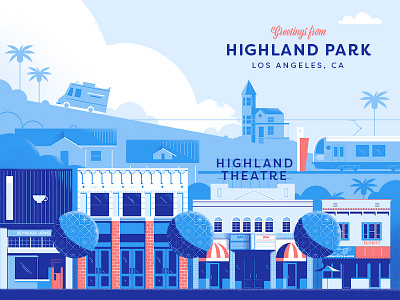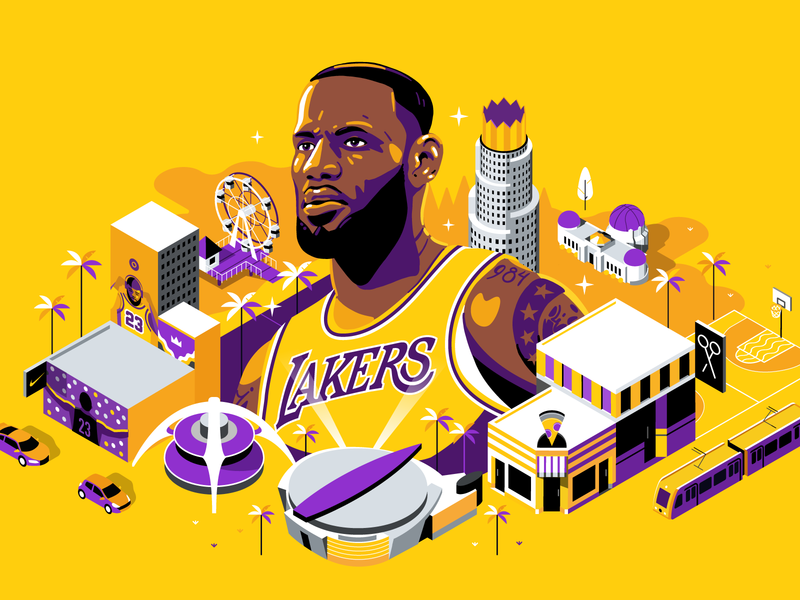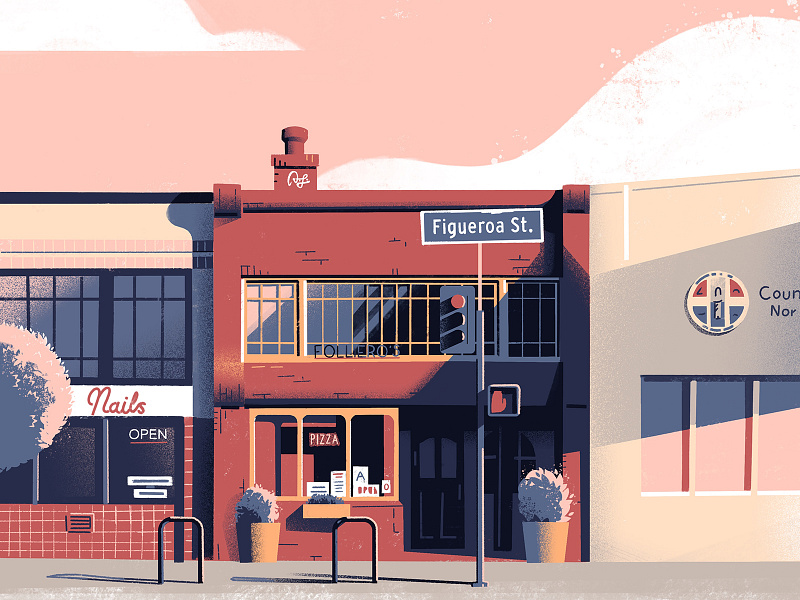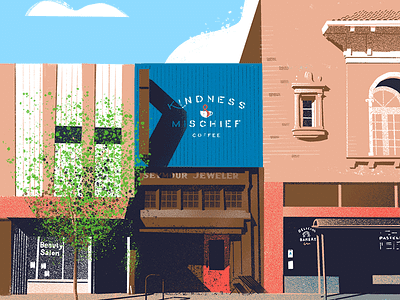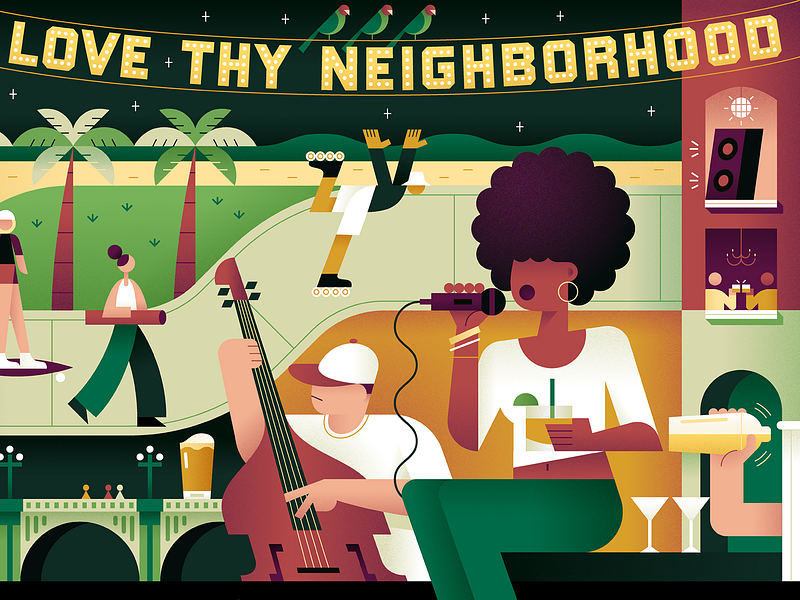Meet the trio behind the Los Angeles-based design studio, Down The Street Designs. Paul, Colin, and Remo all met in school and shortly after graduating, decided to take a leap of faith and found their very own creative studio. In this post, they’ll share how it all started, the challenges of launching a design studio, and solid advice for any creatives looking into starting a studio of their own.
Hi! We are Down The Street Designs and we are a small 3-person illustration/animation studio located in Highland Park, Los Angeles. I like to think that our work is groovy and colorful and 100 percent chill. We can also be serious sometimes but for the most part, we like to emanate feel-good vibes.
How it all started
Paul: We all met in the BFA Graphic Design program at CSU Long Beach. For group projects and in our spare time we’d make animated music videos together. As we approached graduation we realized that there was a life after college that we had to worry about too. Most of our classmates had decided to work at ad agencies or design firms, but we felt the urge to start something of our own. From that idea, Down the Street was born. The studio is named after my original commute which was riding my bike down the street to Colin’s apartment to work on projects.
Colin: When the three of us were illustrating and animating music videos in college, Paul’s boss at the time would let us borrow his office to work in during their after hours. This gave us the opportunity to build our own makeshift studio. It also gave us a little taste of what it would be like to have our own business.
Paul: We’d also set up the computers in really ridiculous ways to take cool photos of our “workspaces” for Instagram. Not believable at all.
Remo: I actually joined Down The Street a little later on so I wasn’t there during its early years. After graduation, I worked at a marketing agency in Orange County as their motion graphics designer. In the spring of 2017, Colin and Paul reached out and asked me to join the team. Being able to work with my friends was an offer I couldn’t pass up.


Challenges of launching a design studio
Colin: We encountered many obstacles when we first started. For one, we needed to learn how to open up an official business. Luckily, YouTube has some awesome tutorial videos on the topic, so we started there. Once we figured out how to open up shop, we then needed to make sure we could land some projects. We reached out to as many people as we could to let them know we existed. We were fortunate enough to have a great support system in the beginning and a majority of our early projects came from our friends and family. We also needed to quickly build our portfolio, so personal projects kept us busy while we had breaks in-between client projects.
Paul: Though our program at CSU Long Beach was great, there wasn’t much focus on the business side of things so gathering information about legal business names, accounting, licensing, etc. was all new to us. Thankfully, the internet is a really good resource for finding step-by-step help on how to complete those kinds of tasks.
Defining services and roles
Remo: I grew up watching anime and drawing all the time so I knew that I wanted to draw for a living. Also, I do remember keyframing a moving square for the first time in a motion graphics class and that just absolutely blew my mind. At that moment I knew animation was something I needed to learn. As for roles, we try to keep things egalitarian for the most part. We all share the same business email so that we are all on the same page and either of us can correspond with clients. We also all have experience in illustration and animation so it’s easy to “hot potato” projects if need be.
Paul: Originally we would accept any project that came our way. However, we’ve always loved working on illustration and animation projects so we would constantly post those kinds of pieces on our site and social media. The kind of work that you put into the universe is the kind of work you’ll be asked to make. Remo has a specialty in designing things that are more graphic and is amazing at creating super cool characters, while I lean towards doing more architectural illustration and frame-by-frame animation. Colin has been focusing on 3D and has been creating some really cool work in that realm. I’m also the designated office-plant waterer.

Finding a steady client base
Colin: Personal projects played a key role in the success of our business. Our passion projects helped showcase our style and the type of work we wanted to do. We developed a good rhythm when we partnered with our representatives, Friend and Johnson . They have helped us maintain a steady influx of projects while allowing us to spend more time on the creative work.
Paul: We also began to network with agencies and bigger studios through our friends who worked at those places. Our friends were so very kind and helpful to us when we started out. In terms of narrowing down the kind of work we accepted, it was really about putting only illustration and animation projects into our social media accounts and website. I wouldn’t recommend displaying work that you don’t enjoy creating.
The studio space
Remo: We have a rather cozy 300 square foot second-floor office space overlooking Figueroa Street in Highland Park. The building used to be an extended stay hotel for construction workers in the 1940s. We each have our own desks and computers along the same wall so it’s easy to glance over and critique each other’s work. Colin has the misfortune of being in the middle so he has to deal with mine and Paul’s incessant chatter. And, of course, we have Paul’s plant jungle in the other corner.
Paul: The office is essentially broken up into two sides, our “work” side and our “not work” side. The “work” side has our desks and computers and the other has a sink, bookshelf, couch, and the plant corner that Colin and Remo have graciously allowed me to over-populate.
Colin: We chose this office location because it was in a perfect rendezvous spot for all 3 of us. Highland Park was the great fit – there is good food, good coffee, cool people, and an LA Metro station all on the same block.



Getting inspired by the Los Angeles community
Colin: We all grew up in the area so LA has always been influential to us. We try to encapture the community and the love we have for our neighborhood in our artwork. It’s a very culturally diverse city so there is an endless supply of inspiration. It’s also always sunny here so that is one factor that is pretty hard to beat. The design community in Los Angeles is great. Everyone is super supportive of each other for the most part and we are lucky to be in a city where there are so many other people who share the same passion as us.
Paul: LA is also home to everything from big, beautiful buildings to small, intimate corners where sparking creativity is always possible. Whether it’s the architecture or the hand-painted typography, there’s always something to be inspired by.
Remo: LA has this quality of being the final destination for people from other parts of the country and world. In the past few decades, LA was filled with an influx of immigrants (e.g. my parents) looking to settle in a place that had perfect weather and a diverse community with folks of a shared language/culture. LA still holds this image of being the entertainment capital of the world – the final frontier where you can make it big if you got lucky. That image has molded LA into a sort of modern creative mecca where all different forms of talent are celebrated.
Lessons learned from starting a creative business
Paul: Be nice. Clients can absolutely love your work and value your talent but, at the end of the day, if you aren’t easy to work with, they will seek an artist elsewhere. That’s not to say you shouldn’t stand your ground if the client is being unreasonable but always do your best to stay calm and be diplomatic when negotiations get tense or deadlines get close.
Remo: Be nice to everyone pretty much. And absolutely never agree to a quote or deadline without giving it some time for thought.
Colin: Surround yourself with an environment and people who inspire you. I definitely would not be in the position I am in today without the constant support and creative fuel I have been given from my partners.

Advice for those thinking about starting a creative studio
Paul: The hardest part of starting a design studio with your peers is the start itself. It may be best to work a steady job and in your free time do the best you can to begin accumulating a small list of clients to help build your rep and your portfolio. One thing we’d also recommend is to begin networking by reaching out to your friends who work in bigger agencies or studios already. Just start with a simple, “Hey! If your firm is looking to have some outsourced fill in the blank work, let them know I would love to work with you!” This will enable you to more organically make connections since your friends will naturally recommend you (at least we’d hope haha). Also, when you have the means, we believe it’s very important to have a physical place (like a studio or office) to do your work. Having a separate zone from where you live to get work done has been such a huge benefit to us.
Colin: Like Paul was saying, the beginning is always the hardest but just make sure to stay persistent, determined and focused and all the hard work will eventually pay off.
Remo: Give yourself roles, hold each other accountable, communicate often, and listen. Take lots of breaks and give each other gifts. Paul recently gave me a self-care kit from Lush and my skin care game has been upped significantly.
Want to keep up with Down the Street Designs? Find them on Dribbble, Instagram, and at downthestreet.tv
Find more Interviews stories on our blog Courtside. Have a suggestion? Contact stories@dribbble.com.
